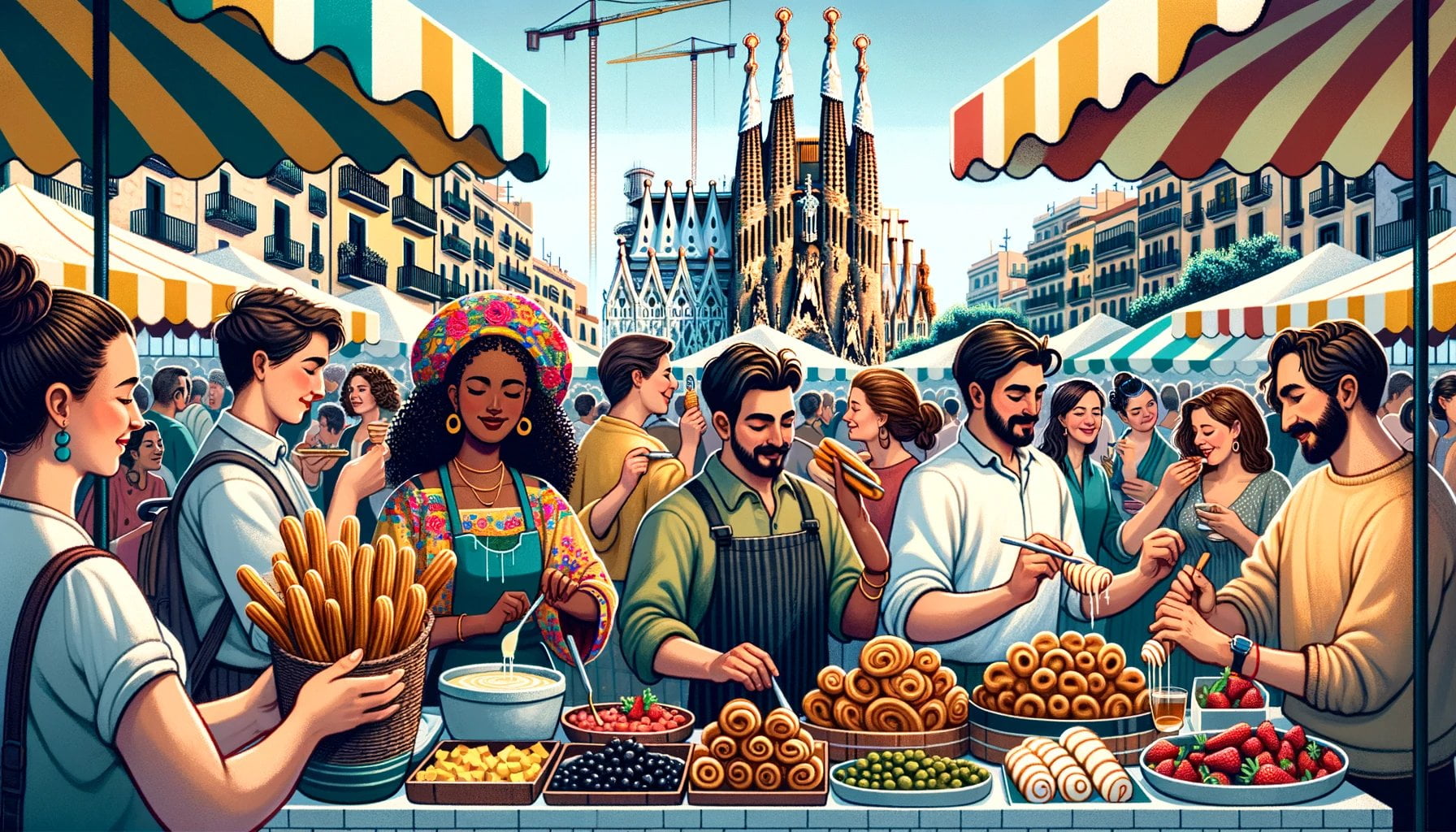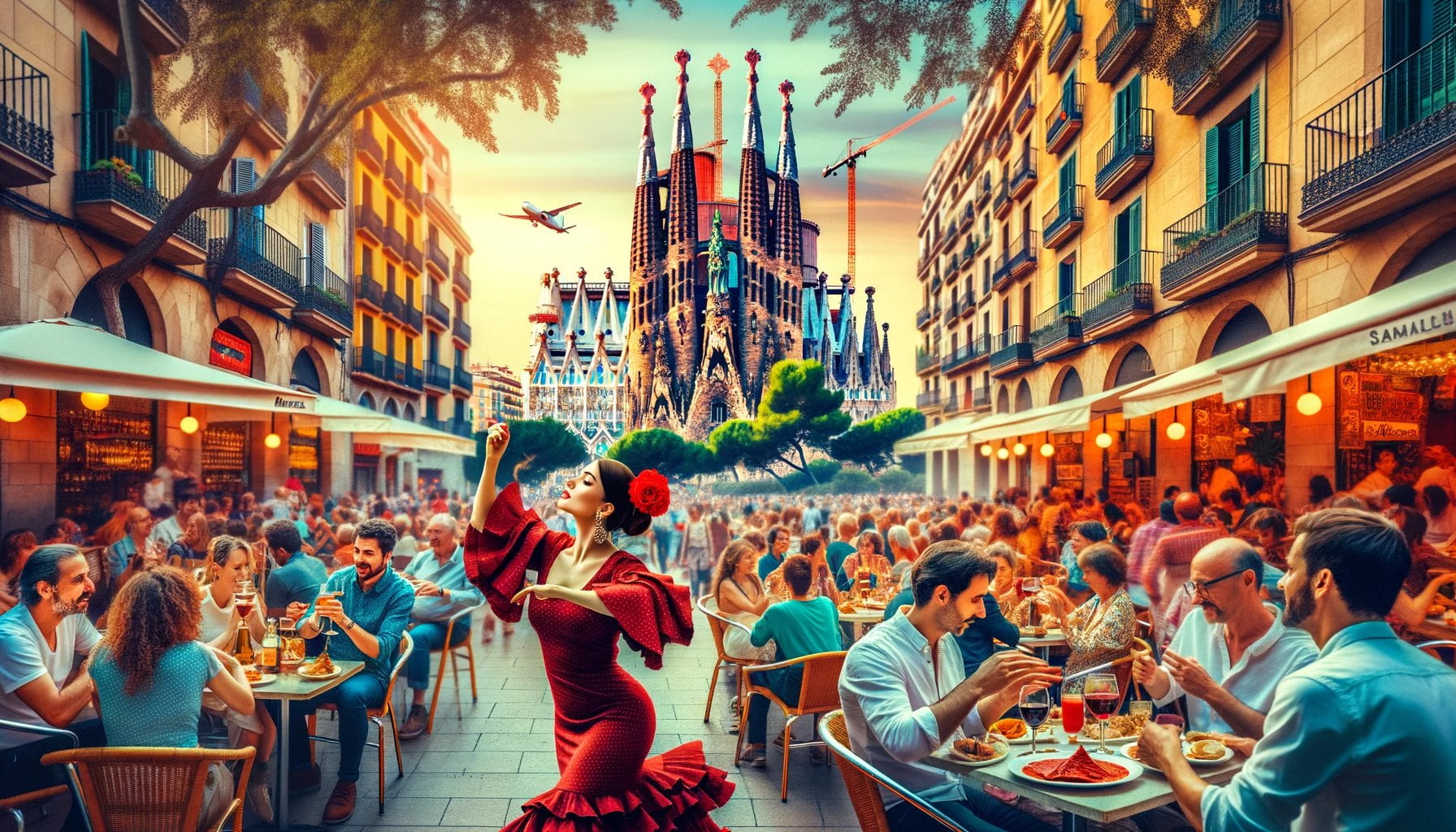If you seek to discover the true essence of Spain and what it is famous for, look no further. “Unveiling the Allure: Exploring Spain’s Flamenco Dances, Architectural Gems, Moorish Heritage, and Delectable Tapas” takes you on a mesmerizing journey through the captivating traditions and unique attractions that make this country an absolute must-visit. From the rhythmic flamenco dances that embody the soul of Spain to the awe-inspiring architectural wonders like the Sagrada Familia, this article delves into the cultural richness and unmissable experiences that await adventurers in every corner of Spain. Moreover, it unravels the tantalizing world of tapas, offering a taste of Spain’s culinary excellence along the way. Prepare to be enchanted by the vibrant Spain that awaits beyond your wildest imaginations.
Key Takeaways:
- Spain’s cultural heritage is deeply rooted in its history and diverse influences, showcased through ancient landmarks, traditions, festivals, and customs.
- The stunning architecture of Spain ranges from Romanesque and Gothic to Moorish and modernist styles, with notable examples like the Sagrada Familia cathedral in Barcelona.
- Spain’s beautiful beaches and warm climate along the Mediterranean Sea and Atlantic Ocean attract tourists from around the world.
- Spanish cuisine is renowned for its delicious flavors and diverse dishes, including iconic favorites like tapas, paella, and olive oil.
- Vibrant cities like Madrid, Barcelona, and Valencia offer a mix of cultural attractions, vibrant nightlife, shopping, dining, and entertainment options.
- Spain has been the birthplace of famous artists like Salvador Dali and Pablo Picasso, whose artworks have made a significant impact on the art world.
For what Spain is famous for?

Spain, a captivating country known for its vibrant flamenco dances, breathtaking architecture, rich Moorish heritage, and delectable tapas, has long been celebrated for its unique and diverse attributes. Let’s delve deeper into what makes Spain famous and why it continues to be a sought-after destination for travelers worldwide.
Cultural Heritage: Spain’s History and Traditions
Spain’s cultural heritage is deeply rooted in its rich history, which spans over centuries and is influenced by various civilizations. The country boasts a wealth of ancient landmarks, traditions, festivals, and customs that epitomize its captivating heritage. From the grandeur of the Alhambra in Granada to the medieval charm of Toledo, Spain offers a journey through time that mesmerizes visitors.
Architecture: Exquisite Designs and Styles
One aspect that distinguishes Spain is its stunning architecture. The country is home to a plethora of architectural styles, each with its own unique charm. Notable examples include the awe-inspiring Sagrada Familia cathedral in Barcelona, an iconic masterpiece designed by the brilliant Antoni Gaudí. From Romanesque and Gothic to Moorish and modernist, Spain’s architectural gems leave an indelible mark on anyone who visits them.
Beaches and Climate: Sun, Sand, and Serenity
Spain’s beautiful beaches and warm climate are another aspect for which it is famous. With a long coastline along the Mediterranean Sea and the Atlantic Ocean, the country boasts an array of beach destinations that cater to all preferences. Whether you seek the vibrant beach culture of Ibiza, the tranquil coves of Menorca, or the golden stretches of the Costa del Sol, Spain offers a paradise for sun-worshippers and water enthusiasts.
Cuisine: A Gastronomic Delight
Spanish cuisine is renowned worldwide for its delicious flavors and diverse dishes. The country’s culinary tradition is rooted in fresh, high-quality ingredients sourced from its fertile lands and surrounding seas. Indulge in the delightful variety of tapas, small plates bursting with flavor and meant for sharing. Don’t miss the iconic paella, a flavorful rice dish cooked with saffron and an assortment of ingredients like seafood or chicken. Spain’s olive oil, famous for its quality and taste, is also highly prized and recognized as the largest producer in the world.
Cities and Nightlife: A Vibrant Urban Experience
Spain’s vibrant cities, such as Madrid, Barcelona, and Valencia, have cemented their place on the global map for their energetic atmosphere and enchanting blend of history and modernity. These cities offer a myriad of cultural attractions, shopping districts, dining experiences, and bustling nightlife. Immerse yourself in the art galleries and museums of Madrid, stroll along Barcelona’s lively Las Ramblas, or experience the futuristic City of Arts and Sciences in Valencia. In these urban hubs, you’ll witness the warmth and hospitality of the Spanish people, making your visit even more special.
Famous Artists: Contributions to the Art World
Spain has been the birthplace of many renowned artists who have left an indelible mark on the art world. Visionaries such as Salvador Dali and Pablo Picasso have shaped artistic movements and continue to be celebrated today. Their artworks have garnered international acclaim, leaving visitors in awe of their talent and the profound emotions they elicit.
Spain’s allure lies in its ability to captivate with every step you take, from the passionate flamenco dances to the immensity of architectural wonders. The country’s cultural tapestry, stunning landscapes, and gastronomic delights ensure that visitors will always find something remarkable to experience. So, what are you waiting for? Embark on a journey to Spain and let its wonders unravel before your eyes.
Sources:
– What is Spain known for? (20 Things It’s Famous For)
– Top 43 Things Spain is Known For
5 facts about Spain
Want to know more about Spain? Explore these amazing 5 facts about Spain to discover the fascinating culture, history, and beauty of this incredible country! Click here to dive into the exciting world of Spain.
Why is Spain so interesting?
Curious about what makes Spain so captivating? Discover the answer to this question and uncover the enchanting allure of Spain by clicking here. Prepare to be amazed by the rich traditions, breathtaking landscapes, and vibrant cities that make Spain truly unique.
What is beautiful about Spain?
Step into a world of beauty as you explore all that Spain has to offer. From picturesque landscapes to stunning architecture, Spain is a country full of wonders that will take your breath away. Click here to immerse yourself in the unparalleled beauty that defines Spain.
Spanish Architecture and Landmarks
Spain is a country renowned for its breathtaking architecture and iconic landmarks that have stood the test of time. From the unique and colorful buildings designed by the famous architect Antoni Gaudí to the majestic cathedrals and palaces that showcase the country’s rich heritage, Spain’s architectural wonders never fail to captivate visitors.
Five Standout Buildings in Spain
- Casa Batlló, Barcelona: One of Antoni Gaudí’s masterpieces, Casa Batlló is a prime example of Spanish architecture. This unique and colorful building stands out with its organic shapes, intricate details, and vibrant colors. The fluid lines and mosaic-covered facade make Casa Batlló a must-visit for architecture enthusiasts. Source
- Alhambra, Granada: Celebrated as one of the world’s most ambitious monuments of Arab architecture, the Alhambra is a true gem in Spain. This stunning complex of palaces and gardens showcases the profound Arab influence on Spanish architecture. With its intricate carvings, decorative arches, and serene courtyards, the Alhambra offers a glimpse into Spain’s Moorish past. Source
- Santiago de Compostela Cathedral, Galicia: Located in the enchanting city of Santiago de Compostela, this majestic Romanesque cathedral holds great significance as it houses the tomb of the apostle St. James. The impressive architecture, including the beautiful facade and the intricate details of the interior, makes this cathedral a pilgrimage site and a must-see landmark in Spain. Source
- Sagrada Familia, Barcelona: Another iconic creation by Antoni Gaudí, the Sagrada Familia is an unfinished basilica that has become a symbol of modernism and spirituality. The grandeur and magnificence of its design, with its towering spires and intricate sculptures, evoke a sense of awe and wonder. A visit to the Sagrada Familia is a truly immersive experience that showcases the genius of Gaudí’s architectural vision. Source
- Estación de Atocha, Madrid: Blending historical and modern elements, the Estación de Atocha in Madrid is a unique architectural gem. This railway station features a stunning glass and iron enclosure that evokes a sense of grandeur. Inside, a tropical garden creates a harmonious connection between architecture and nature, making the Estación de Atocha a captivating testament to Spain’s architectural diversity. Source
Key Takeaways:
- Spain is home to some of the most remarkable buildings and landmarks in the world.
- Antoni Gaudí’s creations, such as Casa Batlló and the Sagrada Familia, are iconic symbols of Spanish architecture.
- The Alhambra in Granada reflects the country’s Arab influence and is a testament to its rich cultural heritage.
- The Santiago de Compostela Cathedral in Galicia is a stunning example of Romanesque architecture and a pilgrimage site.
- The Estación de Atocha in Madrid showcases the fusion of historical and modern elements, creating a unique architectural blend.
- Exploring Spain’s architectural wonders is a truly enriching experience that allows visitors to appreciate the country’s rich history and artistic brilliance.
Spanish Art and Influential Artists
Spain has long been celebrated for its rich cultural heritage, and nowhere is this more evident than in its art. Spanish artists have not only contributed significantly to Western culture but have also changed the way we perceive art through their bold, thought-provoking, and often disturbing creations. From El Greco to Picasso, the influence of Spanish artists can be felt across different artistic movements.
The Legacy of Spanish Artists
Throughout history, Spain has been home to some of the most famous and influential artists the world has ever known. El Greco, born Doménikos Theotokópoulos, was a Greek-origin painter widely recognized for his unique style. His work was characterized by elongated figures, vibrant colors, and a sense of spiritual transcendence. El Greco’s art defied conventional norms and demonstrated his innovative approach to painting.
Another prominent Spanish artist, Francisco Goya, was known for his powerful and often unsettling artworks. Goya’s works explored diverse themes, ranging from political commentary to depictions of human suffering. His use of expressive brushstrokes and dark, brooding tones created a sense of intensity and emotion that left a profound impact on the art world.
In the 20th century, the Spanish art scene witnessed the rise of two iconic figures: Pablo Picasso and Salvador Dalí. Picasso’s contributions to modern art are immeasurable. As a co-founder of the Cubist movement, he challenged traditional notions of perspective and representation. His ability to break down forms and reimagine them in an abstract manner revolutionized the art world.
Dalí, on the other hand, was known for his surreal and dreamlike imagery. His paintings often featured bizarre and fantastical elements that defied logic. Dalí’s ability to blend reality and fantasy created a unique aesthetic that continues to captivate audiences to this day.
Spanish Art Movements and Techniques
Spanish artists have incorporated various styles and techniques in their work, drawing inspiration from different periods and movements. From Gothic and biblical architecture to Renaissance landscapes, Spanish artists have seamlessly integrated these elements into their masterpieces.
One significant technique used by Spanish artists is chiaroscuro. Francisco Zurbarán, in particular, was known for his forceful and realistic use of light and dark contrasts in his paintings. This technique added depth and drama to his religious and contemplative artworks.
Juan Gris, a renowned figure of the Cubism movement, brought a Spanish perspective to this groundbreaking artistic style. His works featured geometric shapes, overlapping planes, and a vibrant color palette. Gris’s contributions to Cubism showcased the versatility and adaptability of Spanish artists.
Joaquín Sorolla, an impressionist painter, had a distinctive artistic style characterized by loose brushwork and vibrant colors. His ability to capture the fleeting moments of everyday life, especially in his beach scenes, made him one of the most celebrated artists of his time. Sorolla’s brush strokes and use of light added a sense of movement and liveliness to his paintings.
Spanish Art’s Enduring Influence
The impact of Spanish art extends far beyond its historical context. Spanish artists have inspired significant artistic currents and even generated their movements, modifying the international art world on more than one occasion. Their works continue to serve as a source of inspiration for contemporary artists, demonstrating that Spanish art is a living and evolving tradition.
From the works of El Greco and Goya, which challenged artistic conventions, to the innovative approaches of Picasso and Dalí, Spanish artists have left an indelible mark on the art world. Their contributions have influenced not only the realm of visual arts but also literature, music, and film.
Key Takeaways:
– Spanish artists such as El Greco, Goya, Picasso, and Dalí have greatly contributed to Western culture and have changed the way we see art.
– Spanish artists have incorporated various styles and techniques in their work, drawing inspiration from different periods and movements.
– The use of chiaroscuro, geometric shapes in Cubism, and vibrant colors in impressionism are key elements of Spanish art.
– Spanish artists have inspired significant artistic currents and have even generated their movements, modifying the international art world.
– Spanish art continues to grow and evolve, inspiring contemporary artists today.
Sources:
– Spanish Artists Who Have Shaped Western Art
– 10 Famous Spanish Painters Who Made an Impact
Spanish History and Cultural Heritage
Spain’s allure lies in its rich history and cultural heritage, which have shaped its unique and diverse identity. From ancient civilizations to centuries of dominance by different empires, Spain’s cultural tapestry is vibrant and captivating. Let’s embark on a journey to uncover the essence of Spanish history and explore its cultural treasures.
A Tapestry of Civilizations
Throughout its history, Spain has been influenced by various civilizations, resulting in a rich tapestry of cultures. Celtic and Iberian tribes laid the foundation, followed by centuries of Roman rule that left an indelible mark on the country. However, one of the most significant influences can be traced back to the Moors, who conquered over half of Spain in the 8th century.
The Moorish Legacy
The Moors shaped the landscape, architecture, and culture of Spain, leaving behind a lasting Moorish heritage. The iconic Alhambra in Granada showcases the majestic Arab influence on Spanish architecture, with its intricate carvings, stunning gardens, and serene courtyards. This masterpiece is a testament to the harmonious coexistence of different cultures in Spain.
Celebrating Tradition
Spain is known for hosting the world’s oldest fiesta, showcasing its long-standing tradition and celebration. Festivals like La Tomatina and Running of the Bulls exhibit the Spanish spirit of joy, passion, and togetherness. These events offer a glimpse into Spain’s cultural heritage, where age-old traditions continue to thrive.
The Art of Literature and Gastronomy
Spanish literature has made significant contributions to Western culture, with the creation of the picaresque genre being a prime example. This genre follows the adventures of a rogue protagonist, providing insight into Spain’s social, political, and cultural dynamics.
Moreover, Spain’s gastronomy is renowned worldwide. The enjoyment of tapas as an afternoon snack exemplifies the country’s culinary traditions. From indulging in authentic paella to savoring delectable pintxos, Spain’s diverse dishes captivate the taste buds and reflect its cultural heritage.
The Imprint of Architecture
Spain’s architecture is a sight to behold, with a plethora of styles that leave an indelible mark on visitors. From Antoni Gaudí’s surreal creations like Casa Batlló and the iconic Sagrada Familia to the Santiago de Compostela Cathedral in Galicia, which is a stunning Romanesque cathedral and pilgrimage site, Spain’s architectural wonders showcase its fascinating history and artistic brilliance.
Key Takeaways:
- Spain’s cultural heritage is deeply rooted in its rich history and influenced by various civilizations.
- The Moors left a significant legacy, with their influence evident in Spain’s architecture and culture.
- Spain’s festivals and traditions highlight its long-standing celebration of culture.
- Spanish literature and gastronomy continue to captivate and preserve the country’s traditions.
- The architecture of Spain, from Gaudí’s surreal creations to magnificent cathedrals, reflects its unique identity.
Sources:
– iExplore
– The Discoveries of

FAQ
Q1: What is Spain famous for in terms of its cultural heritage?
A1: Spain is renowned for its cultural heritage, which is deeply rooted in its history and diverse influences. The country has a wealth of ancient landmarks, traditions, festivals, and customs that reflect its rich heritage.
Q2: What are some famous architectural gems in Spain?
A2: Spain is famous for its stunning architecture. Notable examples include the Sagrada Familia cathedral in Barcelona, Casa Batlló designed by Antoni Gaudí, the Alhambra in Granada showcasing Arab influence, Santiago de Compostela Cathedral in Galicia, and Estación de Atocha in Madrid.
Q3: What is Spain known for in terms of beaches and climate?
A3: Spain is known for its beautiful beaches and warm climate. The country has a long coastline along the Mediterranean Sea and the Atlantic Ocean, offering a wide range of beach destinations for tourists.
Q4: What is the significance of Spanish cuisine?
A4: Spanish cuisine is renowned worldwide for its delicious flavors and diverse dishes. Some iconic dishes include tapas, paella, and the use of olive oil. Spain is also the largest olive producer in the world.
Q5: What are some vibrant cities known for their nightlife in Spain?
A5: Spain’s vibrant cities, such as Madrid, Barcelona, and Valencia, are known for their lively atmosphere, vibrant nightlife, and hospitality. These cities offer a mix of cultural attractions, shopping, dining, and entertainment options.
- Unveiling the Enigma: Mansoureh Khojasteh Bagherzadeh’s Public Appearances & Private Life in Iran - July 18, 2025
- Unveiling the Mystery: Mansoureh Khojasteh Bagherzadeh’s Husband: A Rare Glimpse into a Private Life - July 18, 2025
- Unveiling Masoud Khamenei’s Mother: Power, Influence, and Iran’s Future - July 18, 2025
















